Biographies of Top Scientists and Their Discoveries (1800s)
Biographies on the important scientists of the 1800s and their most important discoveries. Written by Henry Smith Williams, M.D. this article is a good introduction for students interested in Science and History.
By Henry Smith Williams, M.D.
Sir Humphry Davy and Thomas Wedgwood
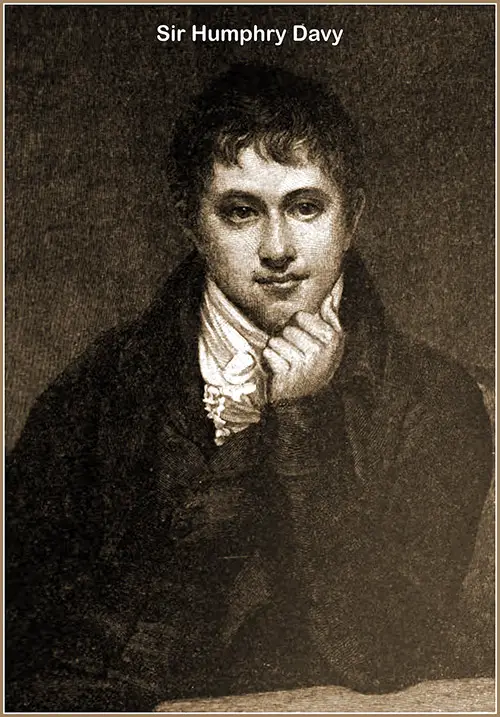
Sir Humphry Davy (1778-1829), From the Painting by H. Howard. The Story of 19th Century Science, 1901, p. 3. GGA Image ID # 1cf1ee323d
Not many months ago, word came out of Germany of a scientific discovery that startled the world. It came first as a rumor, little credited; then as a pronounced report; at last as a demonstration.
It told of a new manifestation of energy, in which the interior of opaque objects is made visible to human eyes. One bad only to look into a tube containing a screen of a particular composition, and directed towards a peculiar electrical apparatus, to acquire clairvoyant vision more wonderful than the discredited second sight of the medium.
Coins within a purse, nails driven into wood, and spectacles within a leather case, became visible when subjected to the influence of this magic tube. When a human hand was held before the tube, its bones were revealed in weird simplicity, as if the living, palpitating flesh about them were the shadowy substance of a ghost.
Not only could the human eye see these astounding revelations, but the impartial evidence of inanimate chemicals could be brought forward to prove that the mind harbored no illusion.
The photographic film recorded the things that the eye might see, and ghostly pictures soon gave a quietus to the doubts of the most skeptical. Within a month of the announcement of Professor Röntgen's experiments, comments upon the "X-ray" and the "new photography" had become a part of the current gossip of all Christendom.
It was but natural that thoughtful minds should have associated this discovery of our boasted latter-day epoch with another discovery made in the earliest infancy of our century.
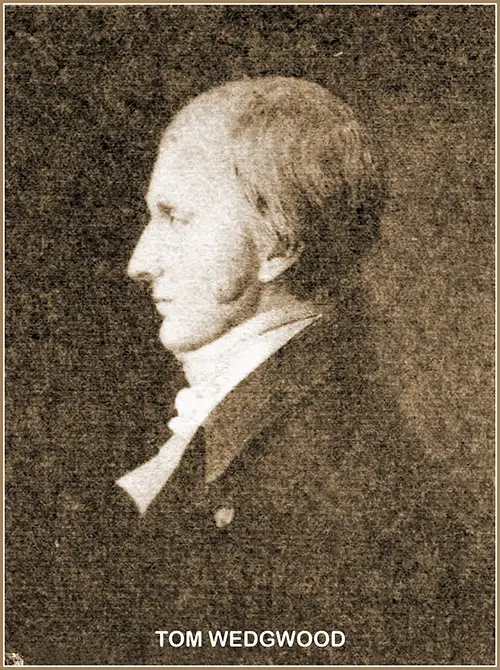
Thomas Wedgwood, From a Chalk Drawing Belonging to Miss Wedwood of Leith Hill Place. Artist Unknown. Tom Wedgwood - First Photographer, 1903, Frontispiece. GGA Image ID # 1cf2770df5
In 1801, Mr. Thomas Wedgwood (Son of Josiah), of the world-renowned family of potters, and Humphry Davy, the youthful but already famous chemist, did experiments that showed it was possible to secure the imprint of a translucent body upon a chemically prepared plate by exposure to sunlight.
In this way, Davy copied translucent pictures. He secured skeletal impressions of such objects as leaves and the wings of insects — imprints strikingly similar to the "shadowgraphs" of more opaque objects, which we connect utilizing the "new photography" today.
But these experimenters little dreamed of the real significance of their observations. It was forty years before practical photography, which these observations foreshadowed, was developed and made of any use outside the laboratory.
It seems strange that imaginative men and Davy indeed was such a man - should have paused on the brink of so great a discovery. But to harbor that thought is to misjudge the nature of the human mind.
Things that have once been done seem easy; things that have not been done are complicated, though they lie a hair's breadth off the beaten track. Whom can today foretell what revelations may be made, what useful arts developed forty years hence through the agency of what we now call the new photography?
However, it is not part of my purpose to attempt the impossible feat of casting a horoscope for the new photography. My present theme is reminiscent, not prophetic.
I wish to recall what knowledge of the sciences men had in the days when that discovery of Wedgwood and Davy was made almost a hundred years ago; to inquire what was the scientific horizon of a person standing at the threshold of our century.
Let us glance briefly at each primary department of the science of that time so that we may know whether men's minds were trending in those closing days of the eighteenth century and what were the chief scientific legacies of that century to its successor.
Frederick William Herschel and his Sister, Caroline Herschel
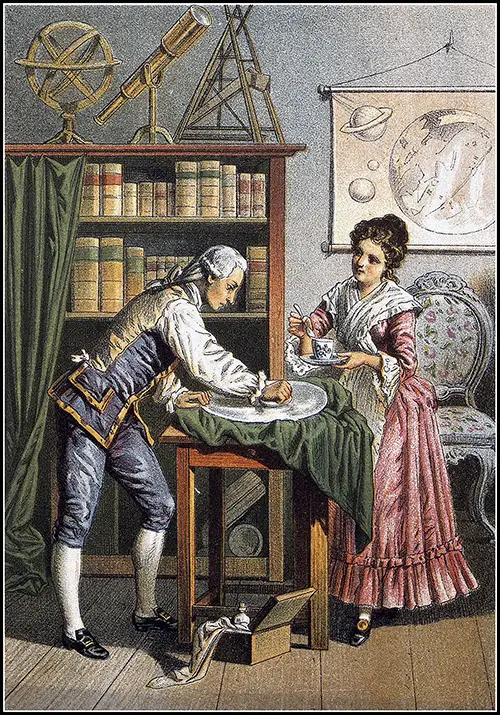
Sir William Herschel and Caroline Herschel, 1896 Lithograph by Welcome Collection Gallery. GGA Image ID # 1cf277f2e1
In the field of astronomy, the central figure during this closing epoch of the eighteenth century is William Herschel, the Hanoverian, whom England has made hers by adoption. He is a man with a positive genius for sidereal discovery.
At first, a mere amateur in astronomy, William snatches time from his duties as a music teacher to grind a telescopic mirror and begins gazing at the stars. Not content with his first telescope, he makes several more, and/he has such genius for the work that he soon possesses a better instrument than was ever made before.
His patience in grinding the curved reflecting surface is monumental. Sometimes for sixteen hours together, he must walk steadily about the mirror, polishing it without removing his hands. Meantime his sister, always his chief lieutenant, cheers him with her presence and puts food into his mouth from time to time.
The telescope completed, the astronomer turns night into day, and from sunset to sunrise, year in and year out, sweeps the heavens unceasingly, unless prevented by clouds or the moon's brightness. His sister always sits at his side, recording his observations.
Still, the two enthusiasts hardly notice a thing so commonplace as terrestrial weather. They are living in distant worlds. They are in the open air, perched high at the mouth of the reflector, and sometimes it is so cold that the ink freezes in the bottle in Caroline Herschel's hand.
The results? What could they be? Such enthusiasm would move mountains. But, after all, moving mountains seems a Lilliputian task compared with what Herschel does with those incredible telescopes.
He moves worlds, stars, a universe--even, if you please, a galaxy of universes; at least he proves that they move, which seems scarcely less incredible; and he expands the cosmos, as man conceives it, to thousands of times the dimensions it had before.
As a mere beginning, he doubles the solar system's diameter by discovering the great outlying planet which we now call Uranus, but which lie christens Georgium Sidus, in honor of his sovereign, and which his French contemporaries, not relishing that name, prefer to call Herschel.
This discovery is a little compared with what Herschel does later on, but it nonetheless gives him a worldwide reputation. Comets and moons aside, this is the first addition to the solar system made in historical times, creating a veritable furor of widespread interest and enthusiasm.
Incidentally, King George is flattered at having a world named after him. He smiles at the astronomer and comes with his court to look at his namesake.
The inspection is highly satisfactory; presently, the royal favor enables the astronomer to escape the thralldom of teaching music and to devote his entire time to the more congenial task of star-gazing.
Thus relieved from the burden of mundane embarrassments, he turns with fresh enthusiasm to the skies, and his discoveries followed one another in bewildering profusion.
He finds various hitherto unseen moons of our sister planets; he makes special studies of Saturn and proves that this planet, with its rings, revolves on its axis; William scans the spots on the sun and suggests that they influence the weather of our earth; in short, he extends the entire field of solar astronomy.
But very soon, this field became too small for him, and his most essential research carried him out into regions of space compared with which the span of our solar system is a mere point.
With his perfected telescopes, he enters abysmal vistas that no human eye ever penetrated before, which no human mind had hitherto vaguely imagined.
He tells us that his forty-foot reflector will bring him light from a distance of "at least eleven and three-fourths millions of miles " -- the light which left its source two million years ago.
The smallest stars visible to the unaided eye are those of the sixth magnitude; this telescope, lie thinks, has the power to reveal stars of the 1342d magnitude.
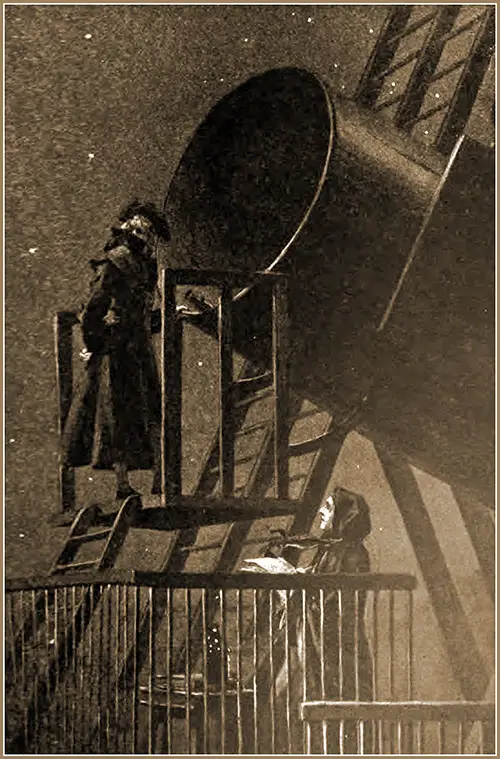
William Herschel (1738-1822) and Caroline Herschel (1750-1848) at the Telescope. The Story of 19th Century Science, 1901, p. 9. GGA Image ID # 1cf2ad6da4
But what does Herschel learn regarding these awful depths of space and the stars that people them? Copernicus, Galileo, and Kepler have given us a solar system, but the stars have been a mystery.
What says the great reflector -- are the stars points of light, as the ancients taught, and as more than one philosopher of the eighteenth century has still contended, or are they suns, as others hold? That is what the world wishes to know.
Herschel answers, they are suns, every one of all the millions -- suns, many of them larger than the one that is the center of our tiny system. Not only so, but they are moving suns. Instead of being fixed in space, as has been thought, they are whirling in gigantic orbits about some common center. Is our sun that center? Far from it.
Our sun is only a star, like all the rest, circling on with its attendant satellites -- our giant sun is a star, no different from myriad other stars, not even so large as some; a mere insignificant spark of matter in an infinite shower of sparks.
Nor is this all. Looking beyond the few thousand stars visible to the naked eye, Herschel sees series after series of more distant stars, marshaled in millions of galaxies. Still, he finally reaches a distance beyond which the galaxies no longer increase. And yet -- so he thinks -- he has not reached the limits of his vision. What then?
He has come to the bounds of the sidereal system, seen to the confines of the universe. He believes that he can outline this system, this universe, and prove that it has the shape of an irregular globe, oblately flattened to almost disc-like proportions and divided at one edge -- a bifurcation that is revealed even to the naked eye in the forking of the Milky Way.
This, then, is our universe as Herschel conceives it -- a vast galaxy of suns, held to one center, revolving, poised in space. But even here, those great telescopes do not pause.
Far, far out beyond the confines of our universe, so far that the awful span of our system might serve as a unit of measure, are revealed other systems, other universes, like our own, each composed. as he thinks, of myriads of suns, clustered like our galaxy into an isolated system -- mere islands of matter in an infinite ocean of space.
So distant from our universe are these new universes of Herschel's discovery that their light reaches us only as a dim nebulous glow, in most cases invisible to the unaided eye.
About a hundred of these nebulae were known when Herschel began his studies. Before the close of the century he has discovered about two thousand more of them, and many of these had been resolved by his largest telescopes into clusters of stars.
He believes that the farthest of these nebula that he can see is at least 300,000 times as distant from us as the nearest fixed star. Yet that nearest star is so remote that its light, traveling 180,000 miles a second, requires three and one-half years to reach our planet:
As if to give the finishing-touches to this novel schemenf cosmology, Herschel, though in the main very little given to un sustained theorizing, allows himself the privilege of one belief that he cannot call upon his telescopes to substantiate. He thinks that all the myriad suns of his numberless systems are instinct with life in the human sense.
Giordano Bruno and a long line of his followers had held that some of our sister planets may be inhabited, but Herschel extends the thought to include the moon, the sun, the stars -- all the heavenly bodies. He believes that he can demonstrate the habitability of our own sun, and reasoning from analogy.
He is firmly convinced that all the suns of all the systems are "well supplied with inhabitants." In this, as in some other inferences, Herschel is misled by the faulty physics of his time. Future generations, working with perfected instruments, may not sustain him all along the line of his observations even, let alone his inferences. But how one's egotism shrivels and shrinks as one grasps the import of his sweeping thoughts!
Continuing his observations of the innumerable nebulae, Herschel is led presently to another curious speculative inference. He notes that some star groups are much more thickly clustered than others, and he is led to infer that such varied clustering tells of varying ages of the different nebulae.
He thinks that at first all space may. have been evenly sprinkled with the stars, and that the grouping has resulted from the action of gravitation. Looking forward, it appears that the time must come when all the suns of a system will be drawn together and destroyed by impact at a common center. Already, it seems to him, the thickest clusters have "outlived their usefulness," and are verging toward their doom.
But again, other nebuke present an appearance suggestive of an opposite condition. They are not resolvable into stars, but present an almost uniform appearance throughout, and are hence believed to be composed of a shining fluid, which in some instances is seen to be condensed at the center into a glowing mass. In such a nebula Herschel thinks he sees a sun in process of formation.
Taken together, these two conceptions outline a majestic cycle of world formation and world destruction--a broad scheme of cosmogony, such as had been vaguely adumbrated two centuries before by Kepler, and in more recent times by Wright and Kant and Swedenborg. This so-called " nebular hypothesis" assumes that in the beginning all space was uniformly filled with cosmic matter in a state of nebular or " fire-mist" diffusion, "formless and void."
It pictures the condensation -- coagulation, if you will -- of portions of this mass Li, form segregated masses, and the ultimate development out of these masses of the sidereal bodies which we see. Thus far the mind follows readily; but now come difficulties. How happens it, for example, that the cosmic mass from which was born our solar system was divided into several planetary bodies in stead of remaining a single mass?
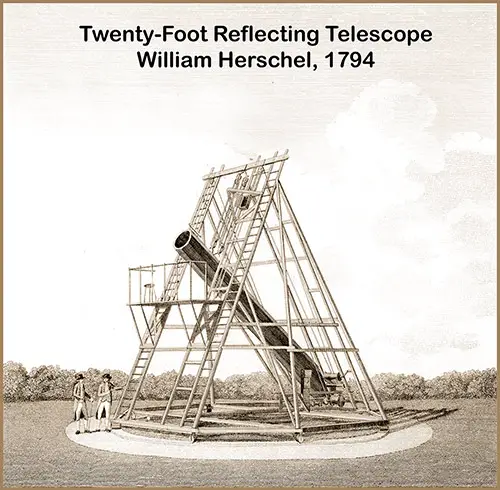
Twenty-Foot Reflecting Telescope of William Herschel, 1794. GGA Image ID # 1cf2ba3539
Were the planets struck off from the sun by the chance impact of comets, as Buffon has suggested ? or thrown out by explosive volcanic action, in accordance with the theory of Dr. Darwin? or do they owe their origin to some unknown law? In any event, how chanced it that all were projected in nearly the same plane as we now find them?
It remained for a mathematical astronomer to solve these puzzles. The man of all others competent to take the subject in hand was the French astronomer Laplace. For a quarter of a century he had devoted his transcendent mathematical abilities to the solution of problems of motion of the heavenly bodies.
Working in friendly rivalry with his countryman Lagrange, his only peer among the mathematicians of the age, he had taken up and solved one by one the problems that Newton left obscure. Largely through the efforts of these two men the last lingering doubts as to the solidarity of the Newtonian hypothesis of universal gravitation had been removed.
The share of Lagrange was hardly less than that of his co-worker; but Laplace will longer be remembered, because he ultimately brought his completed labors into a system, and incorporating with them the labors of his contemporaries, produced in the Mecanique Celeste the undisputed mathematical monument of the century, a fitting complement to the Principia of Newton, which it supplements and in a sense completes.
In the closing years of the century Laplace takes up the nebular hypothesis of cosmogony, to which we have just referred, and gives it definitive proportions; in fact, makes it so thoroughly his own that posterity will always link it with his name.
Discarding the crude notions of cometary impact and volcanic eruption, Laplace fills up the gaps in the hypothesis with the aid only of well-known laws of gravitation and motion. He assumes that the primitive mass of cosmic matter which was destined to form our solar system was revolving on its axis even at a time when it was still nebular in character, and filled all space to a distance far beyond the present limits of the system.
As this vaporous mass contracted through loss of heat, it revolved more and more swiftly, and from time to time, through balance of forces at its periphery, rings of its substance were whirled off and left revolving there, to subsequently become condensed into planets, and in their turn whirl off minor rings that became moons. The main body of the original mass remains in the present as the still contracting and rotating body which we call the sun.
The nebular hypothesis thus given detailed completion by Laplace is a worthy complement of the grand cosmologic scheme of Herschel. Whether true or false, the two conceptions stand as the final contributions of the eighteenth century to the history of man's ceaseless efforts to solve the mysteries of cosmic origin and cosmic structure.
The world listens eagerly and without prejudice to the new doctrines; and that attitude tells of a marvelous intellectual growth of our race. Mark the transition. In the year 1600, Bruno was burned at the stake for teaching that our earth is not the center of the universe.
In 1700, Newton was pronounced " impious and heretical " by a large school of philosophers for declaring that the force which holds the planets in their orbits is universal gravitation.
In 1800, Laplace and Herschel are honored for teaching that gravitation built up the system which it still controls; that our universe is but a minor nebula, our sun but a minor star, our earth a mere atom of matter, our race only one of myriad races peopling an infinity of worlds. Doctrines which but the span of two human lives before would have brought their enunciators to the stake were now pronounced not impious, but sublime.
Dr. James Hutton
One might naturally suppose that the science of the earth, which lies at man's feet, would at least have kept pace with the science of distant stars. But perhaps the very obviousness of the phenomena delayed the study of the crust of the earth. It is the unattainable that allures and mystifies and enchants the developing mind. The proverbial child spurns its toys and cries for the moon.
So in those closing days of the eighteenth century, when astronomers had gone so far towards explaining the mysteries of the distant portions of the universe, we find a chaos of opinion regarding the structure and formation of the earth.
Guesses were not wanting to explain the formation of the world, it is true, but, with one or two exceptions, these are bizarre indeed. One theory supposed the earth to have been at first a solid mass of ice, which became animated only after a comet had dashed against it.
Other theories conceived the original globe as a mass of water, over which floated vapors containing the solid elements, which in due time were precipitated as a crust upon the waters. In a word, the various schemes supposed the original mass to have been ice, or water, or a conglomerate of water and solids, according to the random fancies of the theorists; and the final separation into land and water was conceived to have taken place in all the ways which fancy, quite unchecked by any tenable data, could invent.
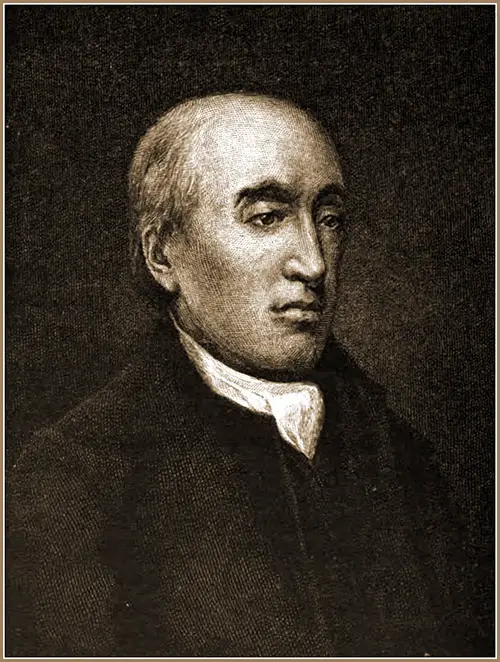
James Hutton, M.D. F.R.S.E., 1726-1797. The Founder of Modern Geology. The Story of 19th Century Science, 1901. GGA Image ID # 1cf2bf6e2e
Whatever important changes in the general character of the surface of the globe were conceived to have taken place since its creation were generally associated with the Mosaic deluge, and the theories which attempted to explain this catastrophe were quite on a par with those which dealt with a remoter period of the earth's history.
Some speculators, holding that the interior of the globe is a great abyss of waters, conceived that the crust had dropped into this chasm and had thus been inundated.
Others held that the earth had originally revolved on a vertical axis, and that the sudden change to its present position had caused the catastrophic shifting of its oceans.
But perhaps the favorite theory was that which supposed a comet to have wandered near the earth, and in whirling about it to have carried the waters, through gravitation, in a vast tide over the continents.
Thus blindly groped the majority of eighteenth-century philosophers in their attempts to study what we now term geology. Deluded by the old deductive methods, they founded not a science, but the ghost of a science, as immaterial and as unlike anything in nature as ally other phantom that could be conjured from the depths of the speculative imagination. And all the while the beckoning earth lay beneath the feet of these visionaries; but their eyes were fixed in air.
At last, however, there came a man who had the penetration to see that. the phantom science of geology needed before all else a body corporeal, and who took to himself the task of supplying it.
This was Dr. James Hutton, of Edinburgh, physician, farmer, and manufacturing chemist; patient, enthusiastic, level-headed devotee of science.
Inspired by his love of chemistry to study the character of rocks and soils, Hutton had not gone far before the earth stood revealed to him in a new light. He saw, what generations of predecessors had blindly refused to see, that the face of nature everywhere, instead of being rigid and immutable, is perennially plastic, and year by year is undergoing metamorphic changes.
The solidest rocks are day by day disintegrated, slowly but none the less surely, by wind and rain and frost, by mechanical attrition and chemical decomposition, to form the pulverized earth and clay. This soil is being swept away by perennial showers, and carried off to the oceans. The oceans themselves beat on their shores, and eat insidiously into the structure of sands and rocks. Everywhere, slowly but surely, the surface of the land is being worn away; its substance is being carried to burial in the seas.
Should this denudation continue long enough, thinks Hutton, the entire surface of the continents must be worn away. Should it be continued long enough! And with that thought there flashes on his mind an inspiring conception -- the idea that solar time is long, indefinitely long. That seems a simple enough thought -- almost a truism -- to the nineteenth-century mind; but it required genius to conceive in the eighteenth. Hutton pondered it, grasped its full import, and made it the basis of his hypothesis, his " theory of the earth."
The hypothesis is this -- that the observed changes of the surface of the earth, continued through indefinite lapses of time, must result in conveying all the land at last to the sea; in wearing continents away till the oceans overflow them. What then ? Why, as the continents wear down, the oceans are filling tip. Along their bottoms the detritus of wasted continents is deposited in strata,together with the bodies of marine animals and, vegetables. Why might. not this debris solidify to form layers of rocks. --the basis of new continents? Why not, indeed?
But have we any proof that such formation of rocks in an ocean-bed has, in fact, occurred ? To be sure we have. It is furnished: by every bed of limestone, every outcropping fragment of fossil-bearing rock, every stratified cliff. How else than through such formation in an ocean-bed came these rocks to be stratified? How else came they to contain the shells of once living organisms, embedded in their depths?
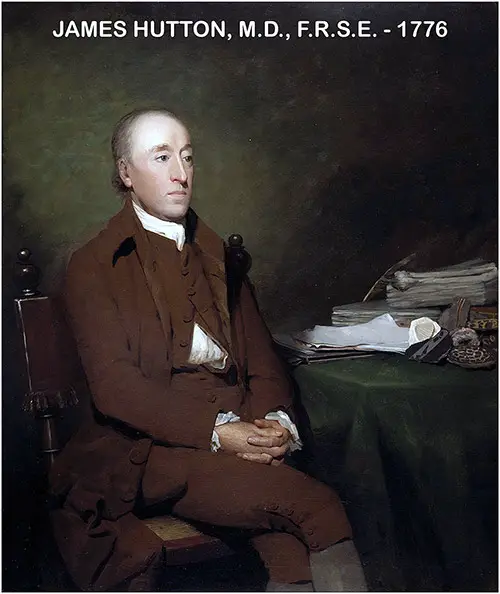
James Hutton, M.D., Geologist From a Oil on Canvas Painting by Sir Henry Raeburn, 1776. GGA Image ID # 1cf34d4b54
The ancients, finding fossil shells embedded in the rocks, explained them as mere freaks of "nature and the stars." Less superstitious generations had repudiated this explanation,but had failed to give a tenable solution of the mystery. To Hutton it is a mystery no longer. To him it seems clear that the basis of the present continents was laid in ancient sea-beds, formed of the detritus of continents yet more ancient.
But two links are still wanting to complete the chain of Hutton's hypothesis. Through what agency has the ooze of the ocean-bed been transformed into solid rock ? And through what agency has this rock been lifted above the surface of the water, to form new continents ?
Hutton looks about him for a clew, and soon he finds it. Everywhere about us there are outcropping rocks that are not stratified, but which give evidence to the observant eye of having once been in a molten state.
Different minerals are mixed together; pebbles are scattered through masses of rock like plums in a pudding; irregular crevices in otherwise solid masses of rock -- so-called veinings -- are seen to be filled with equally solid granite of a different variety, which can have gotten there in no conceivable way, so Hutton thinks, but by running in while molten, as liquid metal is run into the moulds of the founder.
Even the stratified rocks, though they seemingly have not been melted, give evidence in some instances of having been subjected to the action of heat. Marble, for example, is clearly nothing but calcified limestone.
With such evidence before him, Hutton is at no loss to complete his hypothesis. The agency which has solidified the ocean-beds, he says, is subterranean heat. The same agency, acting excessively, has produced volcanic cataclysms. up heaving ocean-beds to form continents. The rugged and uneven surfaces of mountains, the tilted and broken character of stratified rocks everywhere, are the standing witnesses of these gigantic upheavals.
And with this the imagined cycle is complete. The continents, worn away and carried to the sea by the action of the elements, have been made over into rocks again in the ocean-beds, and then raised once more into continents.
And this massive cycle, in Hutton's scheme, is supposed to have occurred not once only, but over and over again, times without number. In this unique view ours is indeed a world without beginning and without end; its continents have been making and unmaking in endless series since time began.
Hutton formulated his hypothesis while yet a young man, not long after the middle of the century. He first gave it publicity in 1781, in a paper before the Royal Society of Edinburgh, a paper which at the moment neither friend nor foe deigned to notice.
It was not published in book form till the last decade of the century, when Hutton had lived with and worked over his theory for almost fifty years. Then it caught the eye of the world.
A school of followers expounded the Huttonian doctrines; a rival school, under Werner, in Germany, opposed some details of the hypothesis; and the educated world as a whole viewed the disputants askance.
The very novelty of the new views forbade their immediate acceptance. Bitter attacks were made upon the "heresies," and that was meant to be a soberly tempered judgment which in 1800 pronounced Hutton's theories " not only hostile to sacred history, but equally hostile to the principles of probability, to the results of the ablest observations on the mineral kingdom, and to the dictates of rational philosophy." And all this because Hutton's theory presupposed the earth to have been in existence more than six thousand years.
Thus it appears that though the thoughts of men had widened, in these closing days of the eighteenth century, to include the stars, they had not as yet expanded to receive the most patent records that are written everywhere on the surface of the earth.
Before Hutton's views could be accepted, his pivotal conception that time is long must be established by convincing proofs. The evidence was being gathered by William Smith, Cuvier, and other devotees of the budding science of paleontology in the last days of the century, but the record of their completed labors belongs to another epoch.
Lieutenant-General Sir Benjamin Thompson, Count Rumford, F.R.S.
The eighteenth-century philosopher made great strides in his studies of the physical properties of matter, and the application of these properties in mechanics, as the steam-engine, the balloon, the optic telegraph, the spinning-jenny, the cotton-gin, the chronometer, the perfected compass, the Leyden jar, the lightning-rod, and a host of minor inventions testify.
In a speculative way he had thought out more or less tenable conceptions as to the ultimate nature of matter, as witness the theories of Leibnitz and Boscovich and Davy, to which we may recur. But he had not as yet conceived the notion of a distinction between matter and energy, which is so fundamental to the physics of a later epoch.
He did not speak of heat, light, electricity, as forms of energy or "force"; he conceived them as subtle forms of matter -- as highly attenuated yet tangible fluids, subject to gravitation and chemical attraction; though lie had learned to measure none of them but heat with accuracy, and this one be could test only within narrow limits until late in the century, when Josiah Wedgwood, the famous potter, taught him to gauge the highest temperatures with the clay pyrometer.
He spoke of the matter of heat as being the most universally distributed fluid in nature; as entering in some degree into the composition of nearly all other substances; as being sometimes liquid, sometimes condensed or solid, and as having weight that could be detected with the balance.
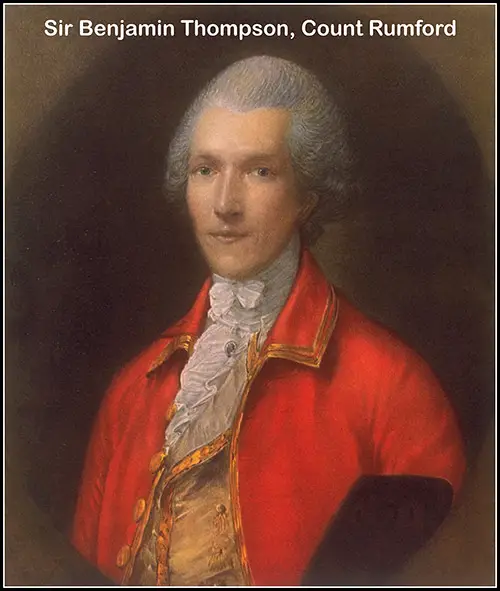
Sir Benjamin Thompson, Count Rumford, FRS in 1783, Painting by Thomas Gainsborough. GGA Image ID # 1cf36ff000
Following Newton, he spoke of light as a "corpuscular emanation " or fluid composed of shining particles which possibly are transmutable into particles of heat, and which enter into chemical combination with the particles of other forms of matter.
Electricity he considered a still more subtle kind of matter -- perhaps an attenuated form of light. Magnetism," vital fluid," and by some even a " gravic fluid" and a fluid of sound, were placed in the same scale; and taken together, all these supposed subtle forms of matter were classed as " imponderables."
This view of the nature of the " imponderables " was in some measure a retrogression, for many seventeenth-century philosophers, notably Hooke and Huygens and Boyle, had held more correct views; but the materialistic conception accorded so well with the eighteenth-century tendencies of thought that only here and there a philosopher, like Euler, called it in question, until well on toward the close of the century. Current speech referred to the materiality of the " imponderables" unquestioningly.
Students of meteorology -- a science that was just dawning -- explained atmospheric phenomena on the supposition that heat, the heaviest imponderable, predominated in the lower atmosphere, and that light, electricity, and magnetism prevailed in successively higher strata. And Lavoisier, the most philosophical chemist of the century, retained heat and light on a par with oxygen, hydrogen, iron, and the rest, in his list of elementary substances.
But just at the close of the century the confidence in the status of the imponderables was rudely shaken in the minds of philosophers by the revival of the old idea of Era Paolo and Bacon and Boyle, that beat, at any rate, is not a material fluid, but merely a mode of motion or vibration among the particles of " ponderable" matter.
The new champion of the old doctrine as to the nature of heat was a very distinguished philosopher and diplomatist of the time, who, it may be worth recalling, was an American.
He was a sadly expatriated American, it is true, as his name, given all the official appendages, will amply testify; but he had been born and reared in a Massachusetts village none the less, and be seems always to have retained a kindly interest in the land of his nativity, even though he lived abroad in the service of other powers during all the later years of his life.
He was knighted by England, ennobled by Bavaria, and honored by the most distinguished scientific bodies of Europe. The American, then, who championed the vibratory theory of heat, in opposition to all current opinion, in this closing era of the eighteenth century, was Lieutenant-General Sir Benjamin Thompson, Count Rumford, F.R.S.
Rumford showed that heat may be produced in indefinite quantities by friction of bodies that do not themselves lose any appreciable matter in the process, and claimed that this proves the immateriality of heat. Later on he added force to the argument by proving, in refutation of the experiments of Bowditch, that no body either gains or loses weight in virtue of being heated or cooled. He thought it proved that heat is only- a mode of motion.
But contemporary judgment, while it listened respectfully to Rumford, was little minded to accept his verdict. The cherished beliefs of a generation are not to be put down with a single blow. Where many minds have a similar drift, however, the first blow may precipitate a general conflict; and so it was here.
Young Humphry Davy had duplicated Rumford's experiments, and reached similar conclusions; and soon others fell into line. Then, in 1800, Dr. Thomas Young" Phenomenon Young" they called him at Cambridge, because he was reputed to know everything -- took up the cudgels for the vibratory theory of light, and it began to be clear that the two " imponderables," heat and light, must stand or fall together; but no one as yet made a claim against the fluidity of electricity.
But before this speculative controversy over the nature of the " imponderables " had made more than a fair beginning, in the last year of the century, a discovery was announced which gave a new impetus to physical science, and for the moment turned the current of speculation into another channel.
The inventor was the Italian scientist Volta; his invention, the apparatus to be known in future as the voltaic pile -- the basis of the galvanic battery. Ten years earlier Galvani had discovered that metals placed in contact have the power to excite contraction in the muscles of animals apparently dead.
Working along lines suggested by this discovery, Volta developed an apparatus composed of two metals joined together and acted on by chemicals, which appeared to accumulate or store up the galvanic influence, whatever it might be. The effect could be accentuated by linking together several such " piles " into a " battery."
This invention took the world by storm. Nothing like the enthusiasm it created in the philosophic world had been known since the invention of the Leyden jar, more than half a century before. Within a few weeks after Volta's announcement, batteries made according to his plan were being experimented with in every important laboratory in Europe.
The discovery was made in March. Early in May two Englishmen, Messrs. Nicholson and Carlyle, practicing with the first battery made in their country, accidentally discovered the decomposition of water by the action of the pile. And thus in its earliest infancy the new science of " galvanism " had opened the way to another new science -- electro-chemistry.
As the century closed, half the philosophic world was speculating as to whether "galvanic influence" were a new imponderable or only a form of electricity; and the other half was eagerly seeking to discover what new marvels the battery might reveal. The least imaginative man could see that here was an invention that would be epoch -making, but the most visionary dreamer could not even vaguely. adumbrate the real measure of its importance.
Hitherto electricity had been only a laboratory aid or a toy of science, with no suggestion of practical utility beyond its doubtful application in medicine; in future, largely as the outgrowth of Volta's discovery, it was destined to become a great economic agency, whose limitations not even the enlarged vision of our later century can pretend to outline.
Joseph Priestly, FRS 1733-1804
Priestly was an English chemist, natural philosopher, separatist theologian, grammarian, multi-subject educator, and liberal political theorist who published over 150 works.
Of all the contests that were waging in the various fields of science in this iconoclastic epoch, perhaps the fiercest and most turbulent was that which fell within the field of chemistry. Indeed, this was one of the most memorable war-fares in the history of polemics. It was a battle veritably Napoleonic in its inception. scope, and incisiveness. As was fitting, it was a contest of France against the world; but the Napoleonic parallel fails before the end, for in this case France won not only speedily and uncompromisingly, but for all time.
The main point at issue concerned the central doctrine of the old chemistry -- the doctrine of Becher and Stahl, that the only combustible substance in nature is a kind of matter called phlogiston, which enters into the composition of other bodies in varying degree, thus determining their inflammability. This theory seems crude enough now, since we know that phlogiston was a purely fictitious element, yet it served an excellent purpose when it was propounded and it held its place as the central doctrine of chemical philosophy for almost a century.
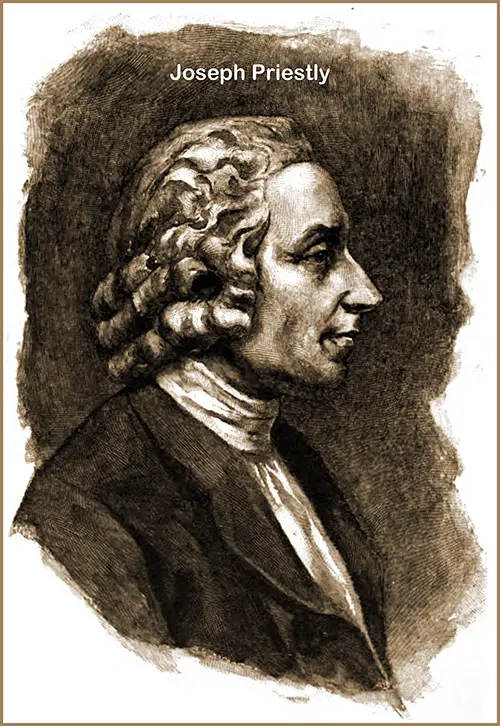
Joseph Priestley FRS (1733-1804). The Story of 19th Century Science, 1901, p. 30. GGA Image ID # 1cf3e45b7a
At the time when this theory was put forward, it must be recalled, the old Aristotelian idea that the four primal elements are earth, air, lire, and water still held sway as the working foundation of all chemical philosophies. Air and water were accepted as simple bodies.
Only a few acids and alkalies were known, and these but imperfectly; and the existence of gases as we now know them, other than air, was hardly so much as suspected.
All the known facts of chemistry seemed then to harmonize with the phlogiston hypothesis; and so, later on, did the new phenomena which were discovered in such profusion during the third quarter of the eighteenth century -- the epoch of pneumatic chemistry.
Hydrogen gas. discovered by Cavendish in 1776, and called inflammable air, was thought by some chemists to be the very principle of phlogiston itself. Other "airs" were adjudged " dephlogisticated " or " phlogisticated," in proportion as they supported or failed to support combustion.
The familiar fact of a candle flame going out when kept in a confined space of ordinary air was said to be due to the saturation of this air with phlogiston. And all this seemed to tally beautifully with the prevailing theory.
But presently the new facts began, as. new facts always will, to develop an iconoclastic tendency. The phlogiston theory had dethroned fire front its primacy as. an element by alleging that flame is due to a union of the element heat with the element phlogiston.
Now earths were-decomposed, air and water were shown to be compound bodies, and at last the-existence of phlogiston itself was to be-called in question. The structure of the-old chemical philosophy had been completely riddled; it was now to be overthrown.
The culminating observation which brought matters to a crisis was. the discovery of oxygen, which was made by Priestley in England and Scheele in Sweden, working independently, in the-year 1774. Priestley called the new element " dephlogisticated air "; Scheele-called it "empyreal air."
But neither Priestley nor Scheele realized the full import of this discovery; nor, for that matter, did any one else at. the moment. Very soon, however, one man at least had an inkling of it. This was the great French chemist Antoine Laurent Lavoisier. It has sometimes. been claimed that he himself discovered oxygen independently of Priestley and Scheele.
At all events, lie at once began experimenting with it, and very soon it dawned upon him that this remarkable substance might furnish a key to the-- explanation of many of the puzzles of chemistry.
He found that oxygen is consumed or transformed during the combustion of any substance in air. He reviewed the phenomena of combustion in the light of this new knowledge.
It seemed to-him that the new element explained them all without aid of the supposititious element phlogiston. What proof, then, have, we that phlogiston exists?
Very soon he is able to answer that there is no proof, no reason to believe that it exists. Then why riot denounce phlogiston as a myth, and discard it front the realm of chemistry?
Precisely this is what Lavoisier purposes to do. He associates with him three-other famous French chemists, Berthollet, Gnyton de Morveau, and Fourcroy, and sets to work to develop a complete system of chemistry based on the new conception. In 1788 the work is completed and given to the world.
It is not merely an epoch-making book; it is revolutionary. It discards phlogiston altogether, alleging that the elements really concerned in combustion are oxygen and heat. It claims that acids are compounds of oxygen with, a base, instead of mixtures of " earth " and water; that metals are simple elements, not compounds of " earth " and " phlogiston "; and that water itself, like air, is a compound of oxygen with another element.
In applying these ideas the new system proposes an altogether new nomenclature for chemical substances. Hitherto the terminology of the science has been a matter of whim and caprice. Such names as "liver of sulphur," "mercury of life," " horned moon," "the double secret," "the salt of many virtues," and the like, have been accepted without protest by the chemical world. With such a terminology continued progress was as impossible as human progress without speech.
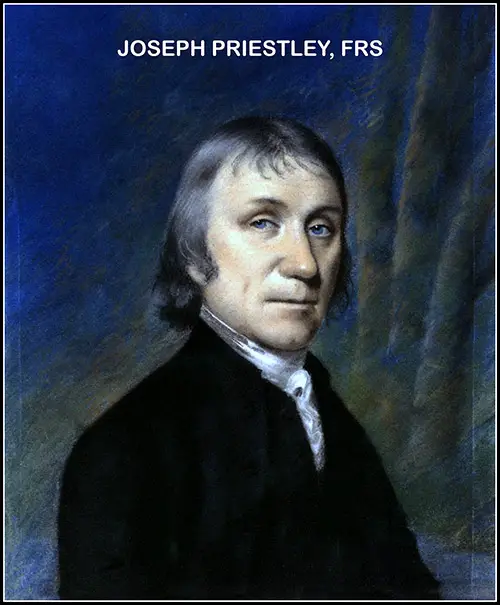
Joseph Priestley, FRS in 1794. Painting by Ellen Sharples. GGA Image ID # 1cf456aaa3
The new chemistry of Lavoisier and his confreres, following the model set by zoology half a century earlier, designates each substance by a name instead of a phrase, applies these names according to fixed rules, and, in short, classifies the chemical knowledge of the time and brings it into a system, lacking which no body of knowledge has full title to the name of science.
Though Lavoisier was not alone in developing this revolutionary scheme, posterity remembers him as its originator. His dazzling and comprehensive genius obscured the feebler lights of his confreres. Perhaps, too, his tragic fate was not without influence in augmenting his posthumous fame. In 1794 he fell by the guillotine, guiltless of any crime but patriotism -- a victim of the " Reign of Terror." "The Republic has no need of savants," remarked the functionary who signed the death-warrant of the most famous chemist of the century.
The leader of the reform movement in chemistry thus died at the hands of bigotry and fanaticism -- rather, let us say, as the victim of a national frenzy -- while the cause he championed was young, yet not too soon to see the victory as good as won. The main body of French chemists had accepted the new doctrines almost from the first, and elsewhere the opposition had been of that fierce, eager type which soon exhausts itself in the effort.
At Berlin they began by burning Lavoisier in effigy, but they ended speedily by accepting the new theories. In England the fight was more stubborn, but equally decisive. At first the new chemistry was opposed by such great men as Black, of latentbeat " - fame; Rutherford, the discoverer of nitrogen; and Cavendish, the inventor of the pneumatic trough and the discoverer of the composition of water, not to mention a coterie of lesser lights; but one by one they wavered and went over to the enemy.
Oddly enough, the doughtiest and most uncompromising of all the champions of the old "phlogistic" ideas was Dr. Priestley, the very man whose discovery of oxygen had paved the way for the " antiphlogistic " movement -- a fact which gave rise to Cuvier's remark that Priestley was undoubtedly one of the fathers of modern chemistry, but a father who never wished to recognize his daughter.
A most extraordinary man was this Dr. Priestley. Davy said of him, a generation later, that no other person ever discovered so many new and curious substances as be; yet to the last he was only an amateur in science, his profession being the ministry. There is hardly an other case in history of a man not a specialist in science accomplishing so much in original research as did Joseph Priestley, the chemist, physiologist, electrician; the mathematician, logician, and moralist; the theologian, mental philosopher, and political economist.
He took all knowledge for his field; but how he found time for his numberless researches and multifarious writings, along with his everyday duties, must ever remain a mystery to ordinary mortals.
That this marvelously receptive, flexible mind should have refused acceptance to the clearly logical doctrines of the new chemistry seems equally inexplicable. But so it was. To the very last, after all his friends had capitulated, Priestley kept up the fight.
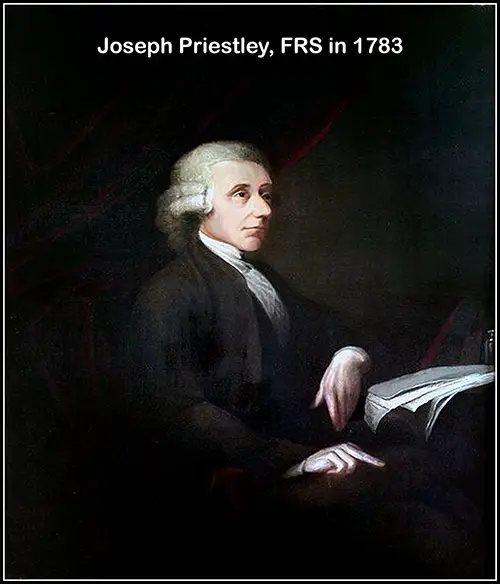
Portrait of Joseph Priestley, FRS circa 1783. Oil on Canvas Painting by Henry Fuseli. GGA Image ID # 1cf45dd632
From America, whither he had gone to live in 1794, he sent out the last defy to the enemy in 1800, in a brochure entitled "The Doctrine of Phlogiston Upheld," etc. In the mind of its author this was little less than a paean of victory; but all the world besides knew that it was the swan-song of the doctrine of phlogiston.
Despite the defiance of this single warrior the battle was really lost and won, and, as the century closed, " antiphlogistic " chemistry had practical possession of the field.
Antoine Laurent Lavoisier
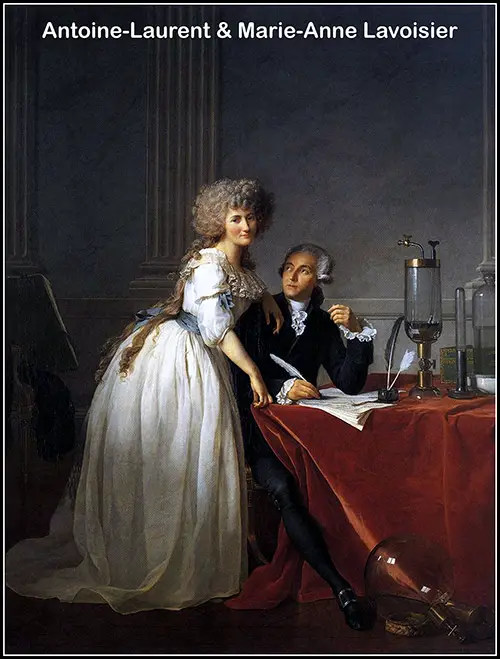
Antoine-Laurent and his Wife, Marie Anne Paulze Lavoisier, 1788. Oil on Canvas Painting by Jacques-Louis David. GGA Image ID # 1cf53b5be8
Several causes conspired to make exploration all the fashion during the closing epoch of the eighteenth century. New aid to the navigator had been furnished by the perfected compass and quadrant and by the invention of the chronometer; medical science had banished scurvy, which hitherto had been a perpetual menace to the voyager; and, above all, the restless spirit of the age impelled the venturesome to seek novelty in fields altogether new.
Some started for the pole, others tried for a northeast or northwest passage to India, yet others sought the great fictitious antarctic continent told of by tradition. All these of course failed of their immediate purpose, but they added much to the world's store of knowledge and its fund of travelers' tales.
Among all these tales none was more remarkable than those which told of strange living creatures found in antipodal lands. And here, as did not happen in every field, the narratives were often substantiated by the exhibition of specimens that admitted no question.
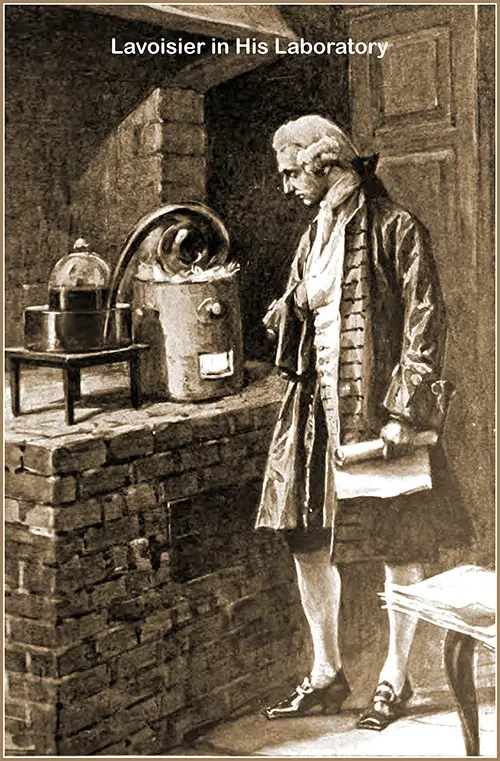
Antoine Laurent Lavoisier in His Laboratory. The Story of 19th Century Science, 1901, p. 37. GGA Image ID # 1cf4d63270
Many a company of explorers returned more or less laden with such trophies from the animal and vegetable kingdoms, to the mingled astonishment, delight, and bewilderment of the closet naturalists.
The followers of Linnaeus in the " golden age of natural history," a few decades before, had increased the number of known species of fishes to about 400, of birds to 1000, of insects to 3000, and of plants to 10,000. But now these sudden accessions from new territories doubled the figure for plants, tripled it for fish and birds, and brought the number of described insects above 20,000.
Naturally enough, this wealth of new material was sorely puzzling to the classifiers. The more discerning began to see that the artificial system of Linnaeus, wonderful and useful as it had been, must be advanced upon before the new material could be satisfactorily disposed of.
The way to a more natural system, based on less arbitrary signs, had been pointed out by Jussieu in botany, but the zoologists were not prepared to make headway toward such a system until they should gain a wider understanding of the organisms with which they had to deal through comprehensive studies of anatomy.
Such studies of individual forms in their relations to the entire scale of organic beings were pursued in these last decades of the century, but though two or three most important generalizations were achieved (notably Kaspar Wolf's conception of the cell as the basis of organic life, and Goethe's all-important doctrine of metamorphosis of parts), yet, as a whole, the work of the anatomists of the period was germinative rather than fruit - bearing. Bichat's volumes, telling of the recognition of the fundamental tissues of the body, did not begin to appear till the last year of the century.
The announcement by Cuvier of the doctrine of correlation of parts bears the same date, but in general the studies of this great naturalist, which in due time were to stamp him as the successor of Linnaeus, were as yet only fairly begun.
In the field of physiology, on the other hand, two most important works were fairly consummated in this epoch -- the long-standing problems of digestion and respiration were solved, almost coincidently.
Two very distinguished physiologists share the main honors of discovery in regard to the function of digestion -- the Abbe Spallanzani, of the University of Pavia, Italy, and John Hunter, of England. Working independently, these investigators showed at about the same time that digestion is primarily a chemical rather than a mechanical process.
It is a curious commentary on the crude notions of mechanics of previous generations that it should have been necessary to prove by experiment that the thin, almost membranous stomach of a mammal has not the power to pulverize, by mere attrition, the foods that are taken into it. However, the proof was now for the first time forth-coming, and the question of the general character of the function of digestion was forever set at rest.
To clear up the mysteries of respiration was a task that fell to the lot of chemistry. The solution of the problem followed almost as a matter of course upon the advances of that science in the latter part of the century. Hitherto no one since Mayow, of the previous century, whose flash of insight had been strangely overlooked and forgotten, had even vaguely surmised the true function of the lungs.
The great Boerhaave had supposed that respiration is chiefly important as an aid to the circulation of the blood; his great pupil, Haller, had believed to the day of his death in 1777 that the main purpose of the function is to form the voice. No genius could hope to fathom the mystery of the lungs so long as air was supposed to be a simple element, serving a mere mechanical purpose in the economy of the earth.
But the discovery of oxygen gave the clew, and very soon all the chemists were testing the air that came from the lungs -- Dr. Priestley, as usual, being in the van. His initial experiments were made in 1777, and from the outset the problem was as good as solved. Other experimenters confirmed his results in all their essentials -- notably Scheele and Lavoisier and Spallanzani and Davy.
It was clearly established that there is chemical action in the contact of the air with the tissue of the lungs; that some of the oxygen of the air disappears, and that carbonic acid gas is added to the inspired air. It was shown, too, that the blood, having come in contact with the air, is changed from black to red in color. These essentials were not in dispute from the first. But as to just what chemical changes caused these results was the subject of controversy. Whether, for example, oxygen is actually absorbed into the blood,or whether it merely unites with carbon given off from the blood, was long in dispute.
Each of the main disputants was biased by his own particular views as to the moot points of chemistry. Lavoisier, for example, believed oxygen gas to be composed of a metal oxygen combined with the alleged element heat; Dr. Priestley thought it a compound of positive electricity and phlogiston; and Humphry Davy, when he entered the lists, a little later, supposed it to be a compound of oxygen and light.
Such mistaken notions naturally complicated matters, and delayed a complete understanding of the chemical processes of respiration. It was some time, too, before the idea gained acceptance that the most important chemical changes do not occur in the lungs themselves, but in the ultimate tissues. Indeed, the matter was not clearly settled at the close of the century.
Nevertheless, the problem of respiration had been solved in its essentials. Moreover, the vastly important fact had been established that a process essentially identical with respiration is necessary to the existence not only of all creatures supplied with lungs, but to fishes, insects, and even vegetables -- in short, to every kind of living organism.
Henry Smith Williams, M.D., "Chapter I. Science at the Beginning of the Century," in The Story of Nineteenth-Century Science, New York-London: Harper & Brothers, 1901.
